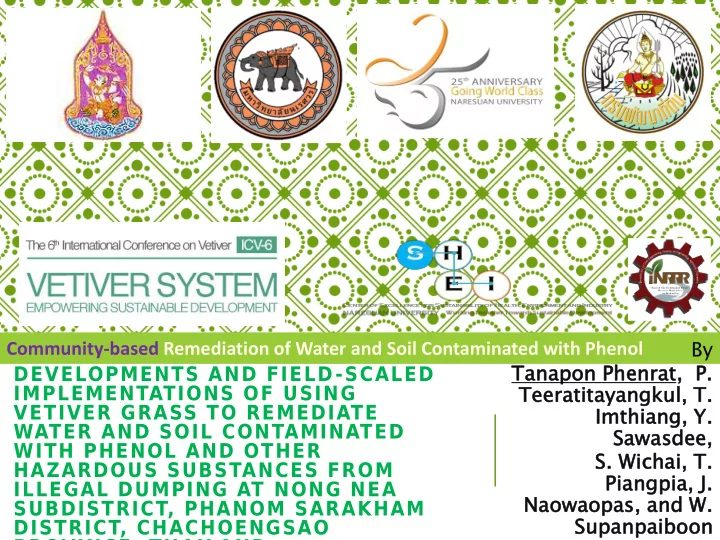

By Community-based Remediation of Water and Soil Contaminated with Phenol LABORATORY-SCALED Tanapo anapon Phenrat enrat, , P. DEVELOPMENTS AND FIELD-SCALED Teera erati titaya ayangkul gkul, , T. IMPLEMENTATIONS OF USING VETIVER GRASS TO REMEDIATE Imthia thiang, , Y. WATER AND SOIL CONTAMINATED Sawasdee awasdee, WITH PHENOL AND OTHER S. Wichai chai, , T. HAZARDOUS SUBSTANCES FROM Piang angpia pia, , J. . ILLEGAL DUMPING AT NONG NEA Na Naow owaopa opas, , and d W. . SUBDISTRICT, PHANOM SARAKHAM Supanpai panpaibo boon on DISTRICT, CHACHOENGSAO PROVINCE, THAILAND
ACKNOWLEDGEMENT Funding from Office of the Royal Development Projects Boards through Naresuan University (Grant nos. R2555B098 and R2557A057) His Majesty the King of Thailand’s Chaipattana Foundation and The King of Thailand Vetiver Awards Excellent advice and continuous support from our expert consultants, including Dr. Weerachai Nanakorn, Dr. Narong Chomchalow, Ms. Suwanna Pasiri, and Dr. Pittayakorn Limthong. Trust and involvement from the Nong Nea community who welcomed our research team like a family Chachoengsao Development Station, Land Development Department, Ministry of Agriculture and Cooperatives, Thailand, for supporting vetiver grass for our research Channel 3 and volunteers for field scaled implementation of
CONTAMINATION OF HAZARDOUS SUBSTANCES IN THAILAND
ILLEGAL DUMPING OF INDUSTRIAL WASTE AND WASTEWATER AS CONTAMINATION SOURCES
COMMUNITY CALLS FOR RISK MITIGATION MEASURES WAS ONLY SOURCE ZONE REMOVAL ENOUGH?
RISK: EXPOSURE MODEL Phenol Concentration in Water 250 times greater than the acceptable level
POINT-OF-USE TREATMENT USING OZONE IS UNDER OPERATION BUT IS NOT AN ABSOLUTE SOLUTION Estimated to last 68 years
PHYTOREMEDIATION IS THE SUSTAINABLE SOLUTION Cost st Effec ectiv ive Herbicides, Suit itable able for Large ge TNT, MTBE, Area TCE Phytodegradation Implem plemen enta table ble by Villag lagers ers Mercury Heavy metals Selenium Se, As TCE, PCE Radionuclides TCE/PCE... Organics (PCBs, PAHs) From Pilon-Smits (2005) Annu Rev Plant Biol 56: 15-39
WHILE AROUND THE WORLD>75% CONTAMINATED BY HAZARDOUS ORGANICS http://www.ewmgroup.net/serving_mining_industry.asp
ONLY 10% RESEARCH USING VETIVER FOR PHYTOREMEDIATON OF HAZARDOUS ORGANICS As of May, 4, 2015 Only 6 papers on the topic of vetiver and organic contaminants 52 papers on vetiver and metals
THE KING OF THAILAND AND THE MIRACLE VETIVER GRASS His Majesty's remark to His Excellency Mr. Ampol Senanarong (Privy Councilor) and the Committees of National Research Council of Thailand, given at Kaikung Won Palace on 22 November, 2002 in that “Vetiver is a versatile plant capable for various applications. In addition to the main benefit of soil erosion prevention, vetiver root penetrating into soil can remove toxic substances flowing with water” (RDPB, 2011)
RISK REDUCTION STRATEGY: FROM THE LAB TO THE LIFE
SUGGESTION FROM EXPERT CONSULTANTS OF RDPB DURING FIELD VISIT
THE LAB
LITERATURE: PHYTODEGRADATION OF PHENOL BY VETIVER Source: Singh et al.(2008)Ecotoxicology and Environmental Safety 71 (2008) 671 – 676 Hypothesis of Phytooxidation by H 2 O 2 and Peroxidase Vetiver degrades phenol faster than other plant (such as alfalfa bean)around 7-8 times No Complete Mechanistic Understanding No Field Scaled Application
PROPOSED COMPLETE PHENOL DETOXIFICATION MECHANISM: PHYTOOXIDATION, PHYTOPOLYMERIZATION, AND RHIZOMICROBIAL DEGRADATION
PHENOL DEGRADATION KINETICS: 2-PHASE PROCESS
PHYTOCHEMICALS
RHIZOMICROBE Isolated colonies from treated (b) (a) wastewater and vetiver roots, including (a) Pseudomonas spp., (b) Micrococcus spp. (c) (d) 1,000X magnification, (c) Candida spp. 400X, and (d) Trichosporon spp. 400X.
50 TO 500 TIME INCREASE OF MICROBE AT VETIVER ROOT samples Pheno nol waste e treatmen atment proce cess ss Lot PB Lot P PB1 430 hr (A1) P1 272 hr (C1) P1 416 hr (C2) P1 608 hr (C3) P1 792 hr (C4) Water TPC= 2.4x10^4 TPC= 1.8x10^6 TPC= 8.7x10^6 TPC= 6.8x10^7 TPC= 3.4x10^8 Y&M =<10 Y&M = 10 Y&M = 20 Y&M = 30 Y&M =30 PB5 430 hr (B1) P5 272 hr (D1) P5 416 hr (D2) P5 608 hr (D3) P5 792 hr (D4) TPC= <10^3 TPC= 6.3x10^6 TPC= 8.5x10^6 TPC= 8.3x10^6 TPC= 3.0x10^7 Y&M =<10 Y&M = 30 Y&M = 30 Y&M = 20 Y&M = 30 PB1 430 hr (RA1) P1 272 hr (RC1) P1 416 hr (RC2) P1 608 hr (RC3) P1 792 hr (RC4) Vetiver root TPC= 3.2x10^6 TPC= 3.6x10^8 TPC= 4.0x10^9 TPC=8.7x10^10 TPC=9.5x20^10 Y&M =1.2x10^2 Y&M= 3.0x10^2 Y&M = 4.5x10^2 Y&M = Y&M =2.5x10^2 PB5 430 hr (RB1) P5 272 hr (RD1) P5 416 hr (RD2) 3.8x10^2 P5 792 hr (RD4) TPC= 5.1x10^5 TPC= 3.3x10^8 TPC= 3.1x10^9 P5 608 hr (RD3) TPC=6.2x10^10 TPC=1.5x10^10 Y&M = Y&M = 1.0x10^2 Y&M= 2.5x10^2 Y&M = 2.3x10^2 Y&M = 2.0x10^2 2.8x10^2
SIMPLE TECHNOLOGY WITH COMPLEX BIOCHEMICAL PROCESSES
EFFICIENCY
ROOT BARRIER APPLICATION: ROLE OF MICROBE IN SOIL Phenol degradation rate faster than Phase I in wastewater treatment (k phenol = 0.0033 h -1 ) but similar to that of Phase II (k phenol = 0.0097 h -1 ), as the presence of soil presumably stimulates rhizomicrobial growth
Theoretical calculation suggests FROM LAB TO FIELD 1.5-km vetiver fences with a width of 1.5 m Decrease phenol transport along the 1.5-km creek banks at a removal efficiency of 40% (at a surface water flow velocity of 50 cm/min) Decrease phenol migration through soil (perpendicular to the creek) to the shallow wells at a removal efficiency of around 70% (at a seepage
FROM THE LAB TO THE LIFE WITH SOCIAL ENGAGEMENT
FIELD TREATMENT OF SOURCE ZONE
FROM LAB TO LIFE WITH SOCIAL ENGAGEMENT
SUCCESSFUL FIELD-SCALED APPLICATION ALL BY COMMUNITY Around 50 times faster than without vetiver Safe to Environment and Human
ON-GOING FIELD-SCALED APPLICATION ALL BY COMMUNITY
INSPIRED BY OUR INITIATIVE Simplicity with beautifully complex Non- hazardous mechanisms to live with community Industrial sustainably contaminated by phenol and PAHs Promised with Community to make it better Proposed the use of vetiver covering the landfill to prevent dust problem and to
THANKS FOR YOUR ATTENTION pomph omphen enrat rat@gma @gmail il.c .c om om 31
Recommend
More recommend